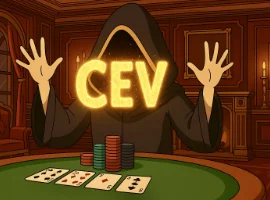Now that you're convinced it’s possible to win in Spin & Go, it’s time to go over the core fundamentals of grinding. And the first essential topic is bankroll management.
You’ve probably heard of this concept already, whether in MTTs, Cash Games, or Spins. Maybe it seems secondary or just not very exciting to you. But bankroll management is a crucial skill for every poker player.
As we’ve seen earlier, even the best players go through downswings — 20, 40, 60, or even more than 80 buy-ins in a row.
Good bankroll management allows you to:
Let’s take a concrete example: you’re a decent Spin & Go player at the €2 level (500 starting chips), performing slightly above average but not crushing the stakes. Let’s say your CEV is 59.
Using Swongsim (yes, we’re getting used to it by now), we can estimate potential losses starting from a bankroll of €500.
As a picture is worth a thousand words, here's a simple graphic explanation:

The lowest your bankroll reaches over a given period. In the graph, this is when your roll drops to €400.
The difference between the highest and lowest points during a period. In the example, the roll went from €1000 to €400, so a 600€ downswing.

Here’s what we can observe:
Swongsim also allows us to analyze the largest potential downswing over 2000 games:

A bankroll going from €500 → €650 → €530 (i.e. -60 buy-ins) is totally normal!
The simulations show that an average player at the €2 level should have at least 85 buy-ins to avoid going bust.
To be safe, we recommend starting with a minimum of 100 buy-ins.
Your skill level also affects these recommendations. The weaker you are at the tables, the deeper your bankroll should be.Here’s what we recommend:
⚠️ Note: these recommendations apply to classic Spins with 500 starting chips. For Spin & Go Nitro, you'll need at least twice the bankroll, due to significantly higher variance.

Let’s imagine that you followed our advice, and started your Spin & Go journey with a 100 buy-in bankroll.
But you're running bad — and now you're down to only 30 buy-ins...
What should you do in this situation? You have three options:
1. Cross your fingers and keep playing... Mathematically, according to the simulations, you’re not “supposed” to go broke. However, there’s a chance you’ve overestimated your skill level (your actual CEV), which would make the simulation results inaccurate for you.

2. Move down in stakes. This is probably the wisest choice. We recommend this route if you no longer feel comfortable with the size of your bankroll.
Drop down a limit, rebuild your roll, regain confidence — and move back up once you're ready to handle the variance again.
3. Re-deposit. This is usually the worst option. It suffers from the same flaw as Option 1: you’re assuming that the downswing is only due to bad luck, when in fact you might be playing below the level you think.
As a result, you could end up repeatedly reloading your bankroll, turning poker into a source of financial loss instead of income.
Remember — the whole purpose of bankroll management is to avoid having to re-deposit!
Want more simulations? Using Swongsim, we can also simulate breakeven stretches — that is, periods where you neither win nor lose money.
And spoiler alert: these periods can be very long…
For example, this graph shows a player experiencing a breakeven period of 1,700 games:

Now let’s look at simulation results to see how common these breakeven stretches are (again, assuming our €2 player with a CEV of 59):

Over 2,000 games:
So yes — long breakeven stretches are a normal part of a winning player’s journey.
Bankroll management is essential to secure your progress.
An average player should start with at least 100 buy-ins, or even 150 for peace of mind.
Downswings and breakeven periods are completely normal: losing 60 buy-ins or not profiting for 700 games can and does happen.













